Altan T. Metal Forming Handbook
Подождите немного. Документ загружается.

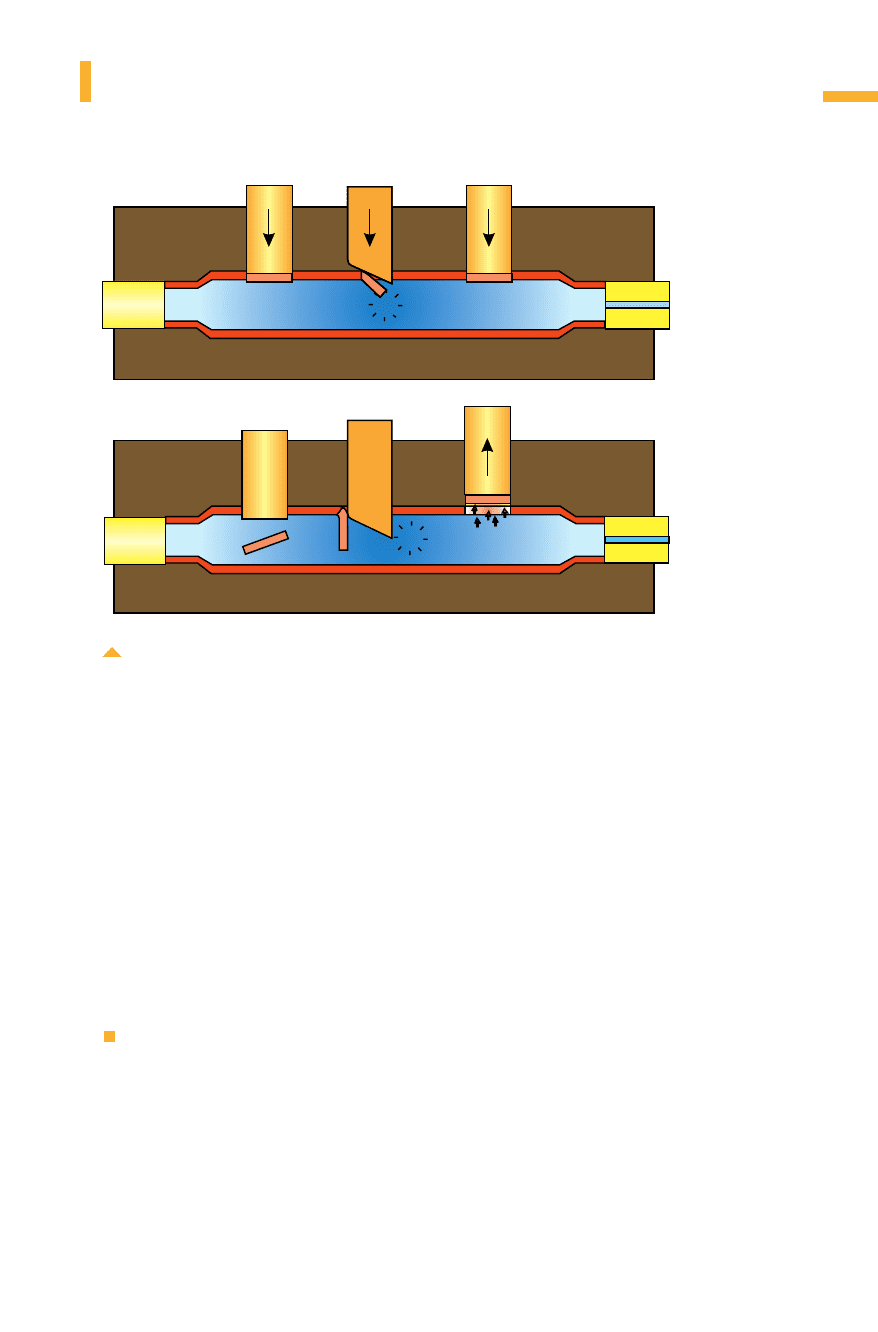
In addition, hole punching, notching, bending or threadingprocesses can be
performed on the part in cases where this has not already been performed
as part of the hydroforming sequence itself (Fig.5.7.2).By calibrating the
part, it is possible to produce special contours at the ends of the tubes. A
separate process is required, generally by means of welding, in order to
assemble add-on componentsor to assemble the part with other components
produced using different production processes. In the case of a production
lot-related multiple pressing,components that are assembled together are
formed in a single pressing process and must be separated by cutting.
5.7.2Technical and economic considerations
The most important technical and economic aspects of hydroforming
are that:
–Components with complex geometries can be manufactured which
previously could not be produced in a single piece.
431
General considerations
Fig. 5.7.2 Hole punching, notching and bending during hydroforming
p
i
p
i
inward
hole punching
notching and
bending over
outward
hole punching
Metal Forming Handbook / Schuler (c) Springer-Verlag Berlin Heidelberg 1998

– The single-part construction eliminates the need for welding seams.
– The calibration process ensures a high degree of accuracy in the con-
tours and dimensions of hydroformed components.
– Strain hardening generally lends hydroformed components a high
degree of torsional rigidity. Their elastic recovery properties are less
pronounced than is the case with welded sheet metal shells. For this
reason, it is often possible for the wall thickness of hydroformed
components to be relatively low compared to cast parts or shell con-
structions. This effect can be used either to reduce weight or to
enhance strength or rigidity.
– Using the same die, it is possible to use and test tubes which, within
certain limits, have different wall thicknesses and starting diameters
and are made of different materials (provided the ultimate deforma-
tion is not exceeded). This allows the weight and strength properties
of the part to be optimized.
– Experience has shown that lower flow resistance and larger fatigue
strength are achieved in exhaust systems.
By selective component and process configuration, it is possible to save
both energy and material and to reduce development and production
times. Thus, generally it is possible to reduce manufacturing costs.
Bibliography
Leitloff, F.-U.: Innenhochdruckumformen mit dem Schäfer-ASE-Verfahren, Stahl (1995) 5.
Malle, K.: Aufweiten - Stauchen - Expandieren, VDI Journal 137 (1995) 9.
N. N.: ASE-Verfahren bringt Hohlkörper in Form, Stahlmarkt (1993) 4.
N. N. : Hochdruckumformen - Fertigungsverfahren mit Zukunft, Stahl (1993) 4.
N. N.: Mit Wasser immer in Form, Automobil-Industrie (1993) 4.
N. N.: Schäfer bringt Hohlkörper in Form, Technische Informationsbroschüre zur Schäfer-ASE-
Technologie, Wilhelm Schäfer Maschinenbau GmbH & Co.
Schäfer, A. W., Fröb, K., Bieselt, R., Hassanzadah, G.: Kaltgeformte T-Stücke für den Anlagenbau –
Anforderungen und technische Realisierbarkeit, 3R International 29 (1990) 9.
432
Hydroforming
Metal Forming Handbook / Schuler (c) Springer-Verlag Berlin Heidelberg 1998

6Solid forming (Forging)
6.1General
Processes and parts
The terms sheet metal forming and solid forming are based on practical
industrial application, and subdivide the field of forming technology
into two distinct areas. This distinction is made in addition to the defi-
nitions established by DIN 8582 “Forming” (cf. Fig. 2.1.3).Solid form-
ing entails the three-dimensional forming of “compact” slugs (for
example sheared billets), while the sheet metal forming method gener-
ally processes “flat” sheet metal blanks to create three-dimensional hol-
low structures with an approximately constant sheet metal thickness.
The forces exerted during solid forming are substantially higher than
those necessary for sheet metal forming. As a result, it is necessary to
use relatively rigid compact-design machines and dies. Solid forming
involves not only the processes of extrusion, indentation and drawing
which are dealt with in most detail here, but also for example rolling,
open die forging (cf. Fig. 2.1.4)or closed die forging (cf. Fig. 2.1.5).
The processes cold extrusion and drawinginvolve forming a slug or bil-
let placed in a die, most commonly for the production of discrete parts.
Hot extrusion uses a basically similar forming mechanism to create
semi-finished products such as rods, tubes and sections.The basic processes
involved in cold extrusion (Fig.6.1.1)are classified depending on their
forming direction as forward, backward and lateral extrusion and also
according to the final form of the workpiece as rod (solid), tube and cup
extrusion. When producing solid parts, the classical operations of cold
extrusion technology are supplemented by processes like upsetting and
ironing (Fig. 6.1.2). The shape variety of parts formed from slugs or bil-
Metal Forming Handbook / Schuler (c) Springer-Verlag Berlin Heidelberg 1998
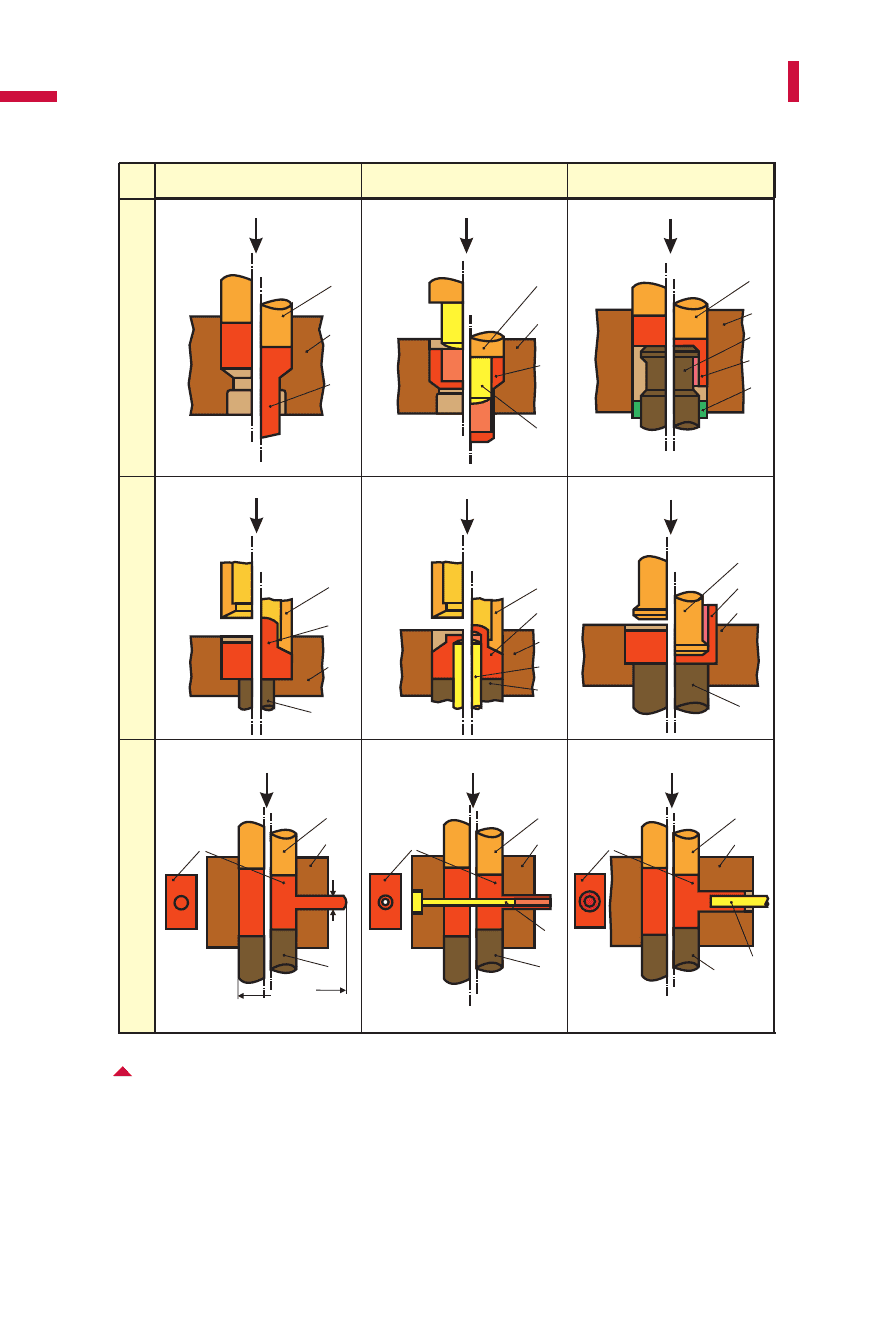
434
Solid forming (Forging)
Fig. 6.1.1 Schematic representation of the cold extrusion (cold forging) processes:
I prior to forging;
II after forging (BDC);
a punch; b container;
c workpiece; d ejector;
e counterpunch; f mandrel
III
III
III
III III
III
III
a
b
c
III
III
a
b
c
d,e
b
c
e
a
a
b
c
f
a
c
b
f
d, e
a
c
b
d,e
a
b
e
c
d
b
c
e
a
b
c
e
a
rod extrusion
tube extrusion cup extrusion
forward extrusion
backward extrusion
lateral extrusion
s
D
1
d
0
f
f
Metal Forming Handbook / Schuler (c) Springer-Verlag Berlin Heidelberg 1998
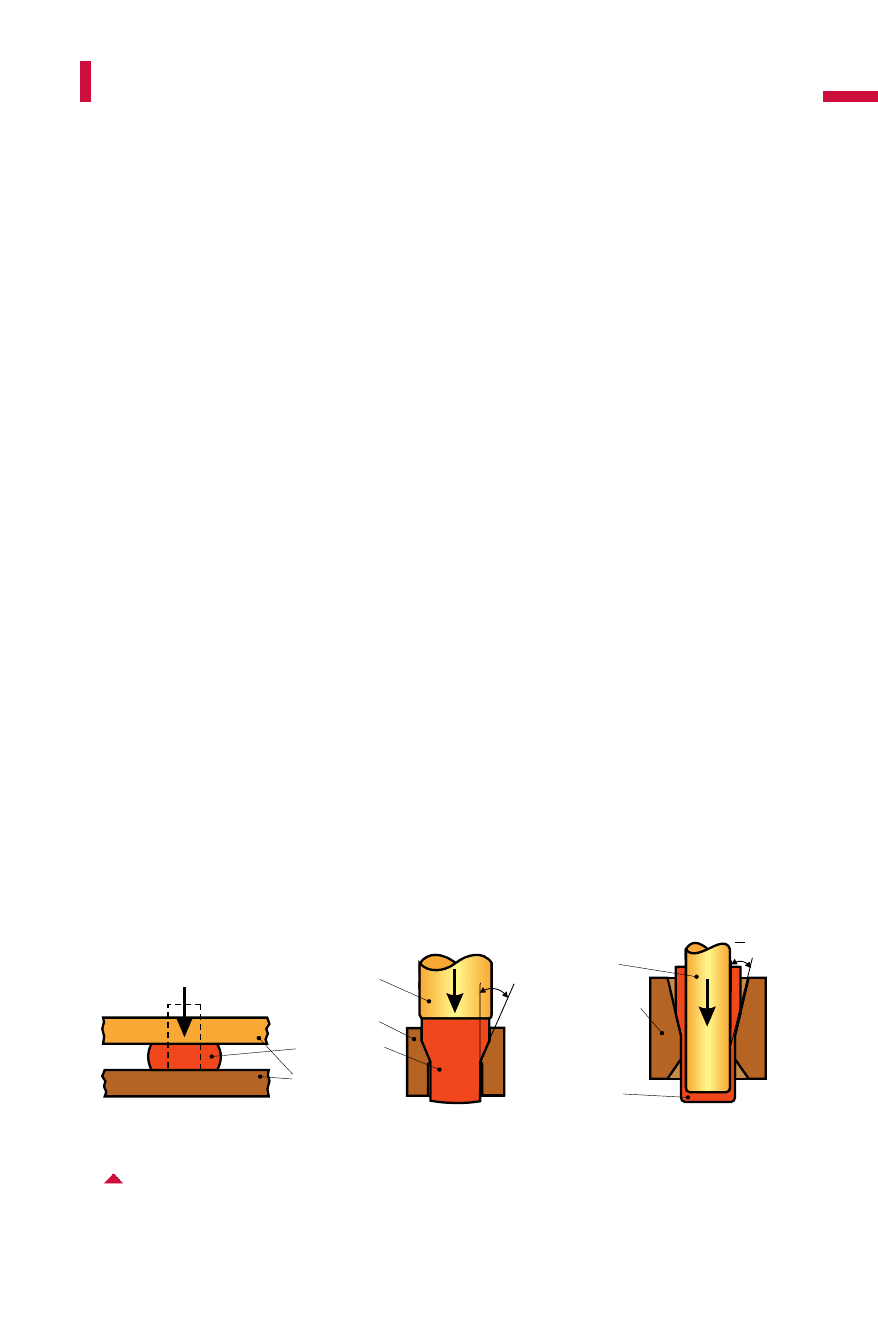
lets that can be produced today is increased substantially by the use of
piercing, flow piercing, trimming and bending processes.
The range of parts includes not only fastening elements(screws, bolts,
nuts, rivets, etc.), but parts for the construction industry(L and T-fittings
for heating systems) and components used in mechanical engineering
applications (ball bearing races, balls, rollers and cages). Most solid
formed parts are used in the automotive and motor cycle industry. Engine
components (valves, camshafts, cams, connecting rods), gear parts (gear
shafts, gear wheels, synchronous rings, differential bevel gears), chassis
components (stud axles, ball hubs, stepped housing elements, shock
absorbers), steering components (steering column joints, tie rod ends),
brake components (brake pistons) and components for electrical motors
(starter motor pinions, drivers, pole rotors), can be economically pro-
duced by solid forming. In addition, solid formed parts are used in
household appliances, office equipment, clocks or medical equipment.
Figure 6.1.3offers an overview of different shapes which can be pro-
duced. The forming techniques described here are currently also used to
producegearsthat can be produced very economically. In many cases,
no machining is necessary or at most one final grinding or hardening
process may be required at the teeth. Components with straight teeth
(spur gears) – such as hub sleeves, bevel wheels and gears –, helical teeth
(e.g. planetary gears, small gears) and special teeth forms (e.g. ring
gears) can be produced. This type of gears can be formed with any
desired tooth that is often involute in shape.
Contours are formed on the surface using the indentation processes
(DIN 8583 sheet 5) coining and roll embossing. Here, the complete
435
General
Fig. 6.1.2 Upsetting, open die extrusion, ironing
upsetting
extrusion
ironing
α
α
punch
punch
ironing die
container
workpiece
workpiece
upsetting die
2
Metal Forming Handbook / Schuler (c) Springer-Verlag Berlin Heidelberg 1998
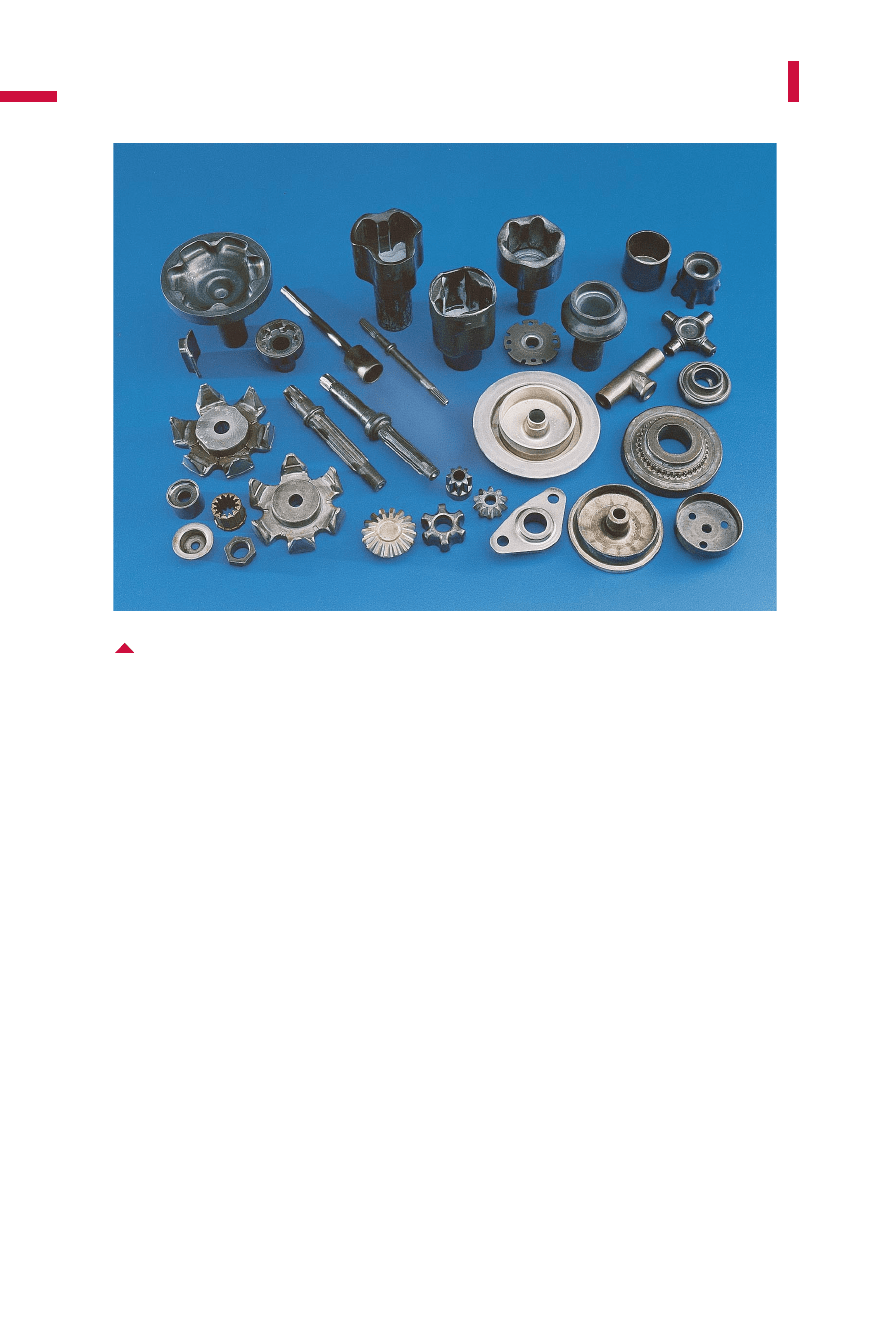
workpiece or the area to be embossed is enclosed in trapped (closed) dies.
During embossing, the part thickness is reduced, in some cases by a con-
siderable amount. Coining is a typical example of an embossing process
(cf. Fig. 2.1.6).Bimetal coins are a good example here, as they involve a
joining process (DIN 8593) combined with coining and roll embossing.
Embossing techniques are also used for example in the production of
road signs, and in the cutlery or hand tool industry (Fig. 6.1.4).
Cold coining of hot forged parts (sizing) (DIN 8583 sheet 4) is used to
improve dimensional, shape and positioning accuracy and/or to
improve surface quality. The objective is to press dimensions and shape
to the required tolerances, and thus avoid the need for subsequent met-
al cutting operations. In contrast to indentation, when using cold coin-
ing, the component already has almost its complete geometry, meaning
that the height reduction during cold coining is relatively small. Sizing
of the bosses in connecting rods (which are required to have a tighter
thickness tolerance compared to castings), and sizing of plier halves
436
Solid forming (Forging)
Fig. 6.1.3 Range of cold, warm and hot forged parts
Metal Forming Handbook / Schuler (c) Springer-Verlag Berlin Heidelberg 1998
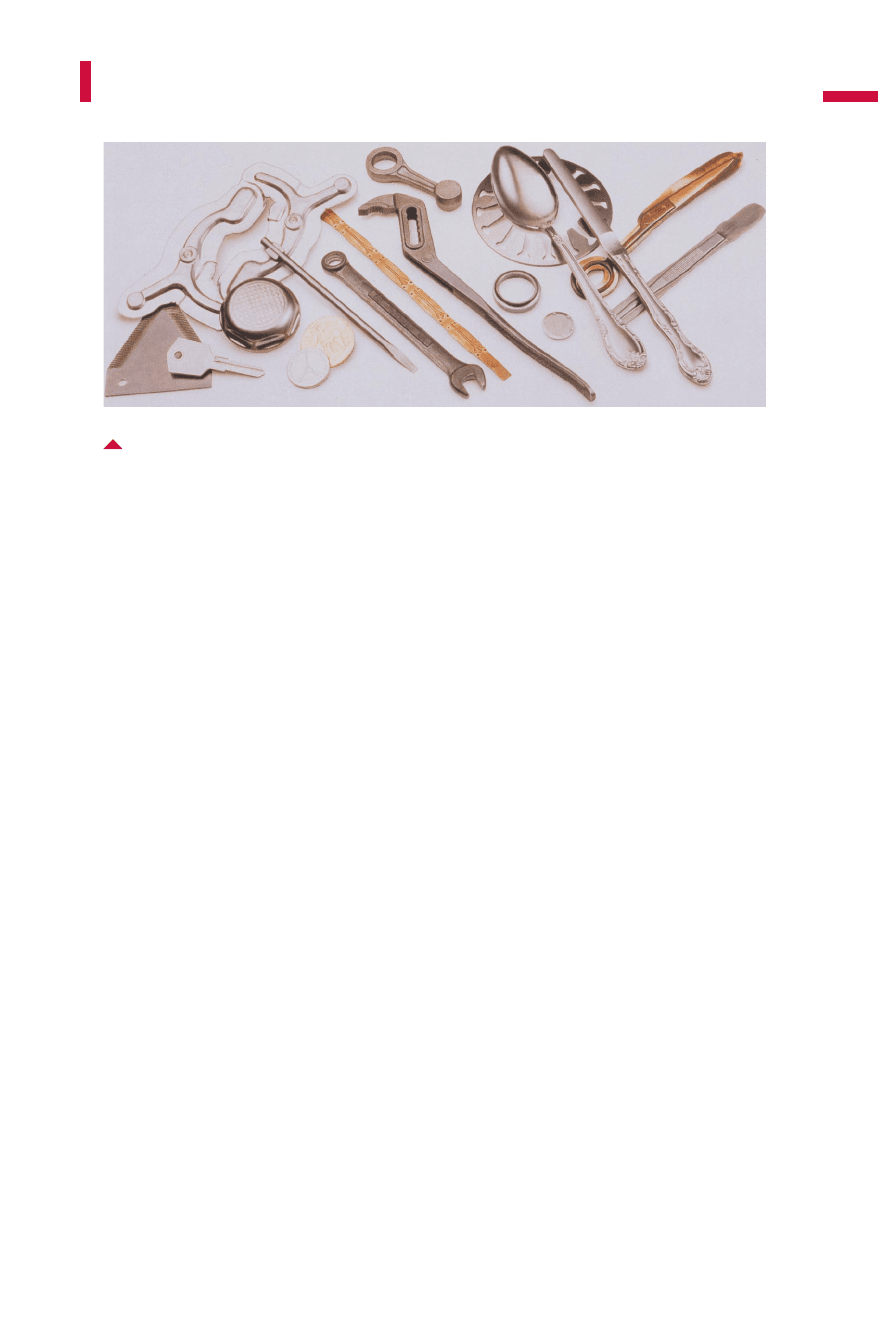
(whose functional surfaces require particular positioning accuracy) are
typical examples of this type of application.
Hot, warm and cold forming and process combinations
It is generally true that almost all solid forming processes can theoreti-
cally be applied at different temperatures. It is only when different fac-
tors come together to create interrelated complexities that either hot,
cold or warm forming emerges as the ideal production method in any
particular case (cf. Sect. 2.2.1). Above the recrystallization temperature,
hot forming(forging)takes place. Forging is the oldest known meta form-
ing technique. If the billet or workpiece is not heated prior to pressing,
the method used is referred to as cold forming (cold forging). This method
did not become feasible for use with steel until the thirties, when a suit-
able separating layer between the die and the workpiece could be
developed. Warm forming (or forging),the last of the three techniques,
developed for the industrial practice, was introduced in the eighties.
For steels, for example, this method works at a temperature range of
between 750 and 950 °C. For many parts and special workpiece materi-
als with a high proportion of carbon, this method combines the tech-
nical advantages of hot forging with those of cold forging for optimum
economical conditions.
The flow stress (Fig.6.1.5)decreases with increasing temperature.
Depending on the material being processed, when using the warm forg-
ing method, the flow stress reaches only around one half to a third of
437
General
Fig. 6.1.4 Examples of coined parts, such as coins, medals, cutlery and various hand tools,
as well as cold-coined hot forged parts
Metal Forming Handbook / Schuler (c) Springer-Verlag Berlin Heidelberg 1998
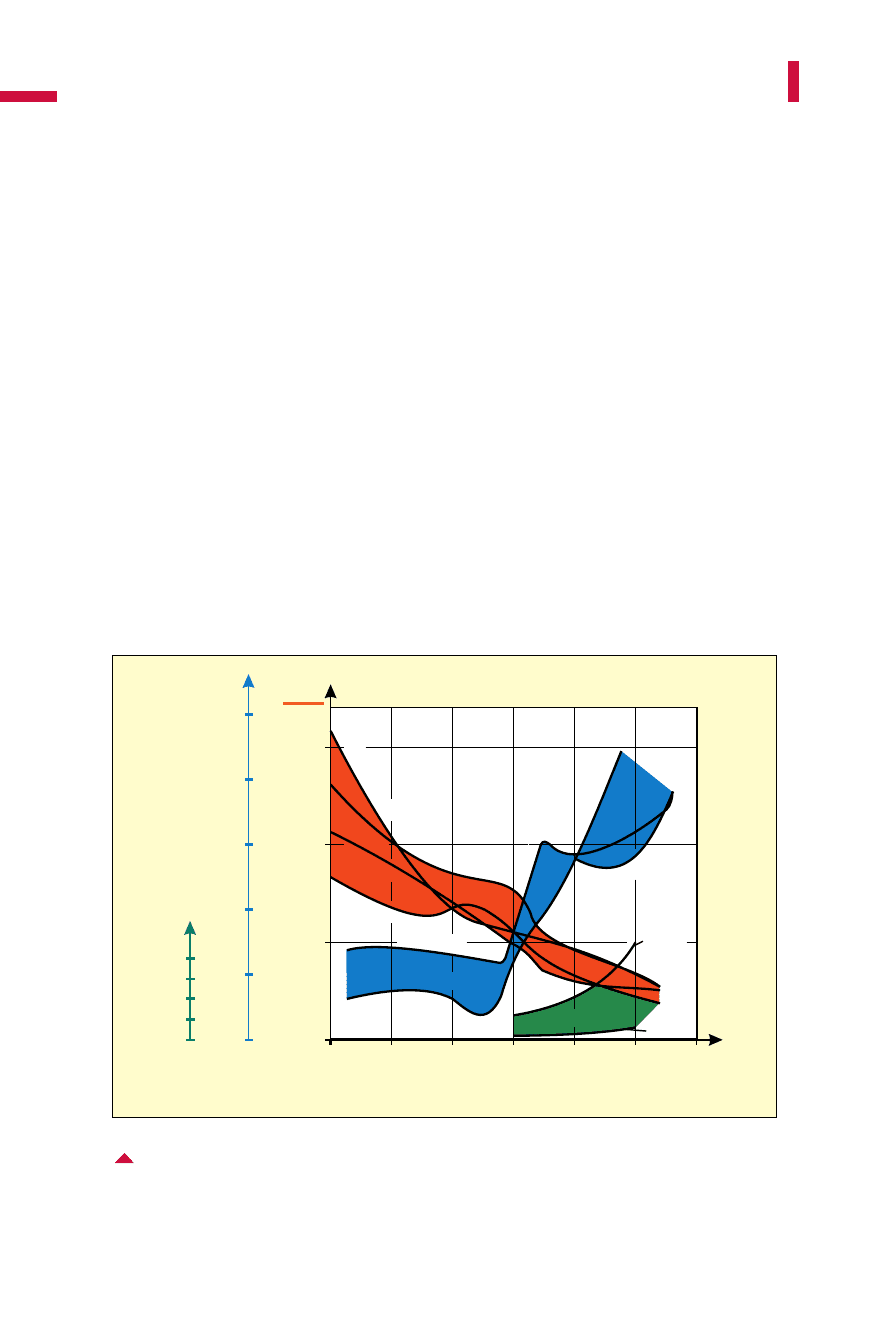
the corresponding values for cold forging. When hot forging, even low-
er flow stress values can be achieved, corresponding to as little as one
fifth of the flow stress level during cold forging. Again depending on
the material used, in warm forging and hot forging respectively forge-
ability is two or six times higher than that in cold forging. In the high-
er temperature range from around 700 °C upwards, the increase in scale
formation which has a detrimental effect on dimensional accuracy and
surface quality of the parts must be taken into account. The tempera-
ture required for warm forging must be carefully selected as in its “low-
er range” it is limited by the size of the press force and the achievable
degree of deformation and in its “upper range” by scale formation.
Table6.1.1 provides a comparison of the advantages of all three
methods on the basis of processing engineering criteria. The weight
of the components produced using hot forging ranges between
0.05 and 1,500kg, in warm and cold forging between 0.001 and 50kg.
Dimensional accuracy and surface quality decrease with increasing
438
Solid forming (Forging)
Fig. 6.1.5 Flow stress, scale formation and achievable degree of deformation (forgeability) in
function of temperature
0
0
500
1000
1500
200
400
600
800 1000
1200
[°C]
forming temperature
flow stress k
f
1
2
3
4
5
0
fracture strain
ϕ
B
N
mm
2
0
scale layer
20
40
60
80
µm
X8CrNiTi1
81
0
C60
X10Cr13
ϕ=70s
.
ϕ=0,7
.
C15
16MnCr5
Ck45
15
5 min
C60
42
Mn
V7
Ck
15
-1
ϕ
= 90s
.
-1
min
Metal Forming Handbook / Schuler (c) Springer-Verlag Berlin Heidelberg 1998

temperature. This is due to thermal expansion, which cannot be pre-
dicted with accuracy, and also to increased die wear.
As an example, let us consider warm forging as the most economical
process for selected parts, subject to technical feasibility. If this process
is then assigned a cost factor of 100, the relative costs of hot forging can
be up to 13% and of cold forging up to 47% higher. Therefore, in warm
and especially hot forging the cost of removing additional material due
to larger machining allowances must be considered. In the case of cold
forging, in contrast, it is frequently possible to compensate completely
for the “highest forming costs” by extremely low or even entirely elim-
inated finishing costs. In extrusion, therefore, cold and warm forging
must be compared as the most economical process alternatives. With
an increasing degree of geometrical complexity (higher degree of defor-
mation, for example for steering knuckles), however, hot forging is still
an economical process.
In practice, the “ideal processes” of solid forming defined here are also
used as process combinations in three different respects. First, almost all
complex workpieces are manufactured today by using multiple-stage
combinations (process or processing step sequence) of individual opera-
tions. To produce a bushing, for example, a combination of the process-
es upsetting, centering, backward cup extrusion, piercing and ironing
are applied in sequence. Second, it is possible for two processes to be car-
ried out simultaneously in a forming operation. Using combined back-
439
General
Table 6.1.1: Comparison between hot, warm and cold forging
Forming
Hot Warm Cold
workpiece weight 0.05 – 1,500 kg 0.001 – 50 kg 0.001 – 30 kg
precision IT 13 – 16 IT 11 – 14 IT 8 – 11
surface quality R
z
. 50 – 100 mm
flow stress ~ 20 – 30 % ~ 30 – 50 % 100 %
formability
f (T, material)
w # 6 w # 4 w # 1.6
“Forming costs“
VDW study 1991,
Darmstadt
up to 113 % 100 % up to 147 %
machining required high low very low
f (T, material)
. 30 µm
. 10 µm
Metal Forming Handbook / Schuler (c) Springer-Verlag Berlin Heidelberg 1998

ward and forward cup extrusion, for example, tube-shaped workpieces
with a central web (Fig.6.1.1)can be produced. These and similar
process combinations reduce the necessary number of processing steps
and generally involve lower press forces than the sum of press forces
used for individual operations. Such process combinations are more eco-
nomical, but are only possible using multiple-action presses and dies.
Third, in forming processes where workpieces are initially hot or
warm forged and then cold forged, “process combination” has also
become an established term. Using this technology, it is possible to
benefit simultaneously, for example, from (a) the economic benefits of
warm forming to create “near-net shape” components and (b) the tech-
nical benefits of cold extrusion or cold forging, in particular its dimen-
sional accuracy and surface quality. In this process, the cold forming
stage is not by any means restricted simply to a sizing operation, but
can include a multiple-stage forging process.
440
Solid forming (Forging)
Metal Forming Handbook / Schuler (c) Springer-Verlag Berlin Heidelberg 1998
